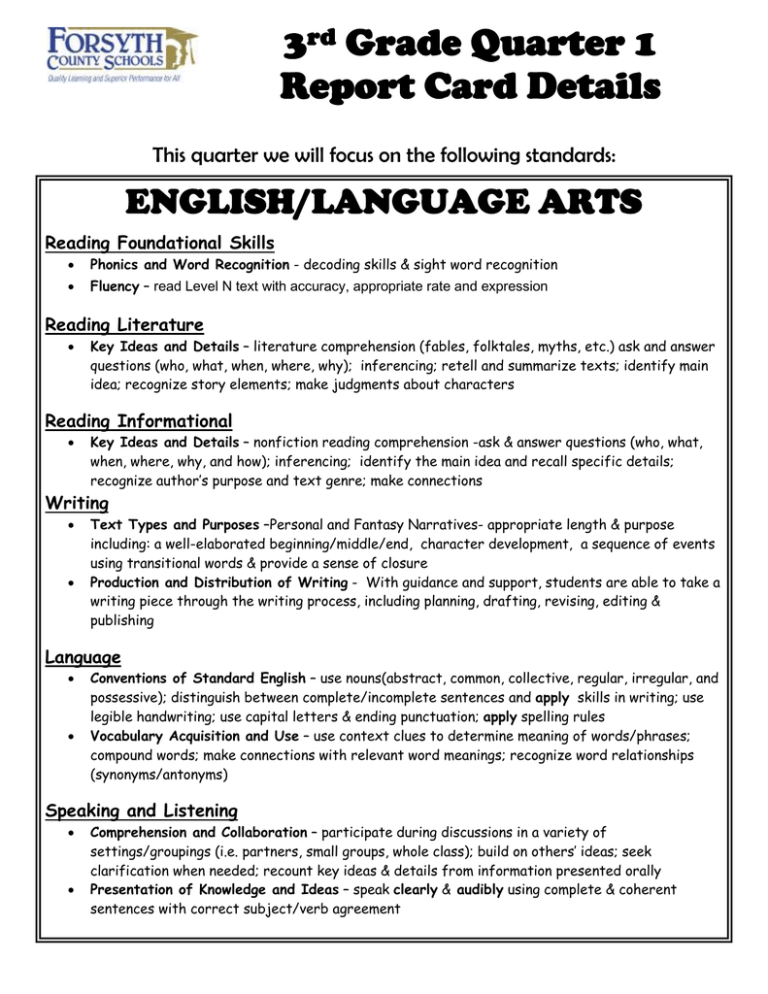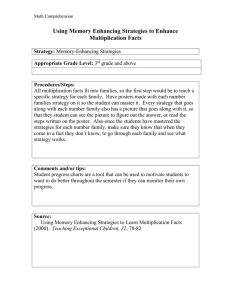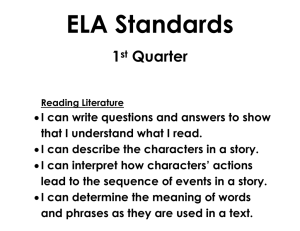3 Grade Quarter 1 Report Card Details ENGLISH/LANGUAGE ARTS
advertisement

3rd Grade Quarter 1 Report Card Details This quarter we will focus on the following standards: ENGLISH/LANGUAGE ARTS Reading Foundational Skills Phonics and Word Recognition - decoding skills & sight word recognition Fluency – read Level N text with accuracy, appropriate rate and expression Reading Literature Key Ideas and Details – literature comprehension (fables, folktales, myths, etc.) ask and answer questions (who, what, when, where, why); inferencing; retell and summarize texts; identify main idea; recognize story elements; make judgments about characters Reading Informational Key Ideas and Details – nonfiction reading comprehension -ask & answer questions (who, what, when, where, why, and how); inferencing; identify the main idea and recall specific details; recognize author’s purpose and text genre; make connections Writing Text Types and Purposes –Personal and Fantasy Narratives- appropriate length & purpose including: a well-elaborated beginning/middle/end, character development, a sequence of events using transitional words & provide a sense of closure Production and Distribution of Writing - With guidance and support, students are able to take a writing piece through the writing process, including planning, drafting, revising, editing & publishing Language Conventions of Standard English – use nouns(abstract, common, collective, regular, irregular, and possessive); distinguish between complete/incomplete sentences and apply skills in writing; use legible handwriting; use capital letters & ending punctuation; apply spelling rules Vocabulary Acquisition and Use – use context clues to determine meaning of words/phrases; compound words; make connections with relevant word meanings; recognize word relationships (synonyms/antonyms) Speaking and Listening Comprehension and Collaboration – participate during discussions in a variety of settings/groupings (i.e. partners, small groups, whole class); build on others’ ideas; seek clarification when needed; recount key ideas & details from information presented orally Presentation of Knowledge and Ideas – speak clearly & audibly using complete & coherent sentences with correct subject/verb agreement MATHEMATICS Operations and Algebraic Thinking Interpret products of whole numbers – interpret 5 X 7 as the total number of objects in 5 groups of 7 objects each Interpret whole-number quotients of whole numbers – interpret 56 ÷ 8 as the number of objects in each share when 56 objects are partitioned equally into 8 shares, or as a number of shares when 56 objects are partitioned into equal shares of 8 objects each. Determine the unknown whole number in a multiplication or division equation relating three whole numbers – for example, 3 x ? = 15 or 21 = 7 x Apply properties of operations as strategies to multiply and divide -if 6 X 4 = 24 is known, then 4 X 6 = 24 is also known. Understand division as an unknown-factor problem – For example, find 32 ÷ 8 by finding the number that makes 32 when multiplied by 8. Fluently multiply and divide within 100, using strategies such as the relationship between multiplication and division Identify arithmetic patterns (including patterns in the addition table or multiplication table) Measurement and Data Represent and interpret data – draw bar graphs and picture graphs; solve problems using information presented in a bar graph Standards for Mathematical Practice Students are given multiple opportunities to acquire and use skills that support the development of critical thinking and application in math. These “process skills” are taught within all of the above math standards. Your child will be developing the following “process skills” throughout the year: persevering in problem solving; communicating thinking and abstract reasoning; justifying answers; using tools, patterns, and objects to model and solve problems appropriately The following assessment methods may be utilized to determine your child's progress toward mastery of the first quarter standards: common written assessments (formative and summative) student performance and participation during class activities and discussions performance tasks teacher observation (whole group and small group) one-on-one assessments (teacher and student) class work, projects, and writing samples Students who consistently demonstrate mastery of standards through regular classroom instruction and assessment will receive a score of "3" (meets standard). Students who consistently demonstrate mastery and independently demonstrate the ability to exceed the standard may receive a score of 4 in a given area.



